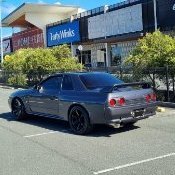QLD Whoretown...
Announcements
-
Similar Content
-
Latest Posts
-
And now to the front. No pics of the 3 nuts holding the front struts on, they are easy to spot. Undo 2 and leave the closest one on loosely. Underneath we have to deal with the wiring again, but this time its worse because the plug is behind the guard liner. You'll have to decide how much of the guard liner to remove, I undid the lower liner's top, inside and lower clips, but didn't pull it full off the guard. Same issue undoing the plug as at the rear, you need to firmly push the release clip from below while equally firmly gripping the plug body and pulling it out of the socket. I used my fancy electrical disconnect pliers to get in there There is also one clip for the wiring, unlike at the rear I could not get behind it so just had to lever it up and out.....not in great condition to re-use in future.
-
Onto the rear lower shock mount. It's worth starting with a decent degrease to remove 10+ years of road grime, and perhaps also spray a penetrating oil on the shock lower nut. Don't forget to include the shock wiring and plug in the clean.... Deal with the wiring first; you need to release 2 clips where the wiring goes into the bracket (use long nose pliers behind the bracket to compress the clip so you can reuse it), and the rubber mount slides out, then release the plug. I found it very hard to unplug, from underneath you can compress the tab with a screwdriver or similar, and gently but firmly pull the plug out of the socket (regular pliers may help but don't put too much pressure on the plastic. The lower mount is straightforward, 17mm nut and you can pull the shock out. As I wasn't putting a standard shock back in, I gave the car side wiring socket a generous gob of dialectric grease to keep crap out in the future. Putting the new shock in is straightforward, feed it into at least 1 of the bolt holes at the top and reach around to put a nut on it to hold it up. Then put on the other 2 top nuts loosely and put the shock onto the lower mounting bolt (you may need to lift the hub a little if the new shock is shorter). Tighten the lower nut and 3 upper nuts and you are done.
-
You will now be able to lift the parcel shelf trim enough to get to the shock cover bolts; if you need to full remove the parcel shelf trim for some reason you also remove the escutcheons around the rear seat release and you will have to unplug the high stop light wiring from the boot. Next up is removal of the bracket; 6 nuts and a bolt Good news, you've finally got to the strut top! Remove the dust cover and the 3 shock mount nuts (perhaps leave 1 on lightly for now....) Same on the other side, but easier now you've done it all before
-
OK, so a bunch of trim needs to come off to get to the rear shock top mounts. Once the seat is out of the way, the plastic trim needs to come off. Remove 2 clips at the top then slide the trim towards the centre of the car to clear the lower clip Next you need to be able to lift the parcel shelf, which means you need to remove the mid dark trim around the door, and then the upper light trim above the parcel shelf. The mid trim has a clip in the middle to remove first, then lift the lowest trim off the top of the mid trim (unclips). At the top there is a hidden clip on the inner side to release first by pulling inwards, then the main clip releases by pulling the top towards the front of the car. The door seal comes off with the trim, just put them aside. The the lighter upper trim, this is easy to break to top clips so take it carefully. There is a hidden clip towards the bottom and another in the middle to release first by pulling inwards. Once they are out, there are 3 clips along the rear windscreen side of the panel that are hard to get under. This is what the rear of the panel looks like to assist:
-
Yes. Autos typically work from the speed sensor on the pinion shaft of the diff. I also think that even if you have a proper speed sensor for the bog manual in the manual box, that the signal it outputs is not compatible with the auto dash anyway. You should consult that manual (the book, not the gearbox).
-






Recommended Posts